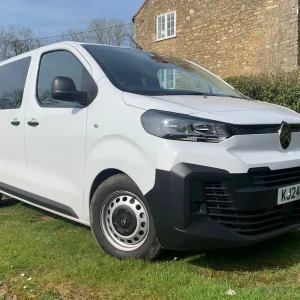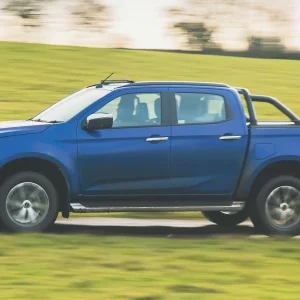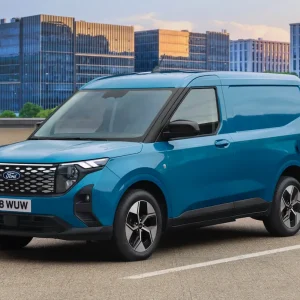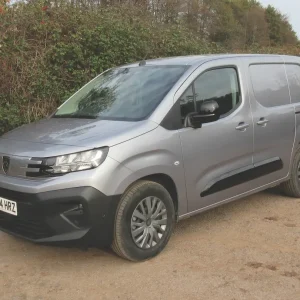The arrival of Renault’s new Master and its success in winning the What Van? LCV of the Year accolade for 2020 along with Vauxhall’s Movano – they share the same design – has somewhat overshadowed the debut of another new offering from the French manufacturer.
As well as revamping the Master, Renault has rejuvenated the front-wheel drive Trafic. This has involved swapping the old 1.6-litre diesel for a 2.0-litre Energy dCi diesel at 120hp, 145hp or 170hp.
Fuel consumption is said to have improved, to the tune of 2.0mpg so far as the 145hp model is concerned.
A 95hp 1.6-litre remains in production, but will not be available on this side of the Channel.
The latest Trafic can be identified by its altered front, with a bolder grille and LED headlamps incorporated into its C-shaped lighting signature. Changes have been made to the dashboard as well, and the Trafic is being marketed with Renault’s latest R-Link Evolution and Media Nav Evolution navigation and multimedia packages.
A six-speed manual gearbox is the standard fare. A six-speed automated EDC6 (Efficient Dual Clutch) twin-clutch ’box sourced from specialist transmission manufacturer Getrag is offered as an option for the first time, and can be specified on the two most powerful models.
Counting Ford’s Transit Custom and VW’s Transporter among its rivals, the Trafic is sold in both short- and long-wheelbase guise and with the choice of either a low or a high roof.
Load cubes range from 5.2m3 to 8.6m3, payload capacities from 1,036kg to 1,255kg, and the Trafic is additionally produced as a six-seater crew van.
Worthy of mention too is the Renault Trafic Passenger nine-seater. A wheelchair-accessible version is also available with a fold-down aluminium ramp.
Three trim levels are on offer – Business, Business+ and Sport – and the Trafic is also marketed by Renault’s sister brand Nissan as the NV300. Fiat Professional sells it as the Talento, but it seems unlikely that it will retain this association with Renault long-term now that Fiat Chrysler Automobiles has inked a merger deal with Citroen, Peugeot and Vauxhall owner PSA.
We got behind the wheel of a LL30 long-wheelbase low-roof Renault Trafic in Sport specification powered by a 170hp engine that’s available solely in Sport derivatives and married to the EDC6 transmission.
Load bay
Access to the 6.0m3 cargo area is by means of sliding doors on both the nearside and (optionally) the offside or through the asymmetric back doors. They can be swung through 90°, and through 170° if you free the easy to release stays. The side doors have internal access steps. Open any of the doors and you will see a full-height steel bulkhead and no less than 18 tie-down points, including eight on the floor.
Our Trafic’s cargo bed was protected against damage by a fitted cover, while the sides, doors and wheelboxes were defended by a mixture of plywood and plastic panels. The liningpackage is an optional extra.

Interior and equipment
Opt for Sport specification and you will not be short of goodies. They include a MediaNav Evolution 7.0in touchscreen system as standard with satellite navigation, a DAB radio, Bluetooth connectivity, aux and USB ports plus Apple CarPlay and Android Auto.
Our Trafic also boasted manual air-conditioning, an optional reversing camera – the image is shown on the screen in the middle of the dashboard, with reversing sensors housed in the back bumper – and heated and electrically adjustable exterior rear-view mirrors, which come with a separate, lower, wide-angle section.
Both the mirror casings and the front bumper are finished in the same colour as the body.
Other features include a smartphone cradle, cruise control with a speed-limiter, a trip computer, a 12V power point, electric windows, and remote controls for the DAB radio on the steering column.
Front fog lamps are included in the deal too, as are automatic headlights and wipers and a driver’s airbag. The passenger airbag is an optional extra.
Storage facilities include a roomy glovebox that, alas, is not lockable, plus a compartment on top of the dashboard with an ill-fitting lid. The lids on other Trafics we have driven fit poorly too, suggesting that Renault needs to pay more attention to build quality.
An open compartment on top of the dashboard can accommodate an A4 clipboard. There are two bins in each of the three-seater cab’s doors, and if you pull up the passenger seat cushions you will find plenty of space for any valuable tools you want to conceal underneath.
That assumes, of course, that you are not making use of the van’s load-through facility.
If you are attempting to transport something that is a bit too long for the cargo bed, you can open a flap at the bottom of the bulkhead and push the end of the item into the 54-litre void beneath the seats. If you need more length you can open a flap in the seat base and push the item right into the passenger footwell. Both flaps are held open by magnets and give you an overall length of 4,150mm.
The centre passenger seat’s cushion and back are narrower than those of the neighbouring seats, and the legroom available to its occupant is limited due to the way the dash bulges outwards.
Flip the back down and it turns into a desk with an elasticated band to keep paperwork in place, a removable A4 clipboard that can be fixed vertically to face either the driver or the passenger, and a cupholder. Space is also created that allows a laptop to be stowed safely.
Did we mention cupholders? There is one at each extremity of the fascia plus a third in the middle next to the gear lever, which has to be folded down before it can be used.
One of Trafic’s cleverest features is housed in the passenger-side sun visor. It is a wide-angle mirror that enables the driver to see what or who is lurking in the van’s nearside blind spot. A cyclist sitting there could be hit if the driver – unaware of their presence – turns left.
Both the leather-trimmed steering wheel and the driver’s seat are height-adjustable, while the steering wheel can be adjusted for reach too.
Disc brakes are fitted all round – ventilated at the front, solid at the back. Alongside ABS with electronic brakeforce distribution, the Trafic’s built-in safety systems include electronic stability control with load adaptive control, which automatically adjusts its performance in line with how much weight the van is carrying, and hill-start assist.
Press a button on the dashboard and Grip Xtend will cut in should you require better traction on soft ground.
What the Trafic does not have, however, are some of the safety devices now appearing on other vehicles, such as lane departure warning and automatic emergency braking with pedestrian detection, for example.
Turning to the suspension, MacPherson struts with an anti-roll bar are fitted at the front. A twist-beam suspension set-up, with hydraulic dampers and a Panhard rod to aid lateral location of the axle, helps support the rear.
The 17.0in alloy wheels – standard on Sport – were shod with Goodyear EfficientGrip 215/60 R17C tyres.
Power-assisted steering offers a 13.73m turning circle between walls narrowing to 13.17m between kerbs.

Engine and gearbox
Equipped with a variable-geometry turbocharger, the Trafic’s four-cylinder common-rail 16-valve diesel produces maximum power at 3,500rpm. Top torque of 380Nm kicks in at 1,500rpm.
Selective catalytic reduction is fitted, which means that AdBlue from a 20-litre reservoir is required to help ensure the engine meets Euro6d-temp emission standards.
driving
Ignition keys have changed radically over the past few years. Our Trafic came with an optional flat piece of plastic that functions as a hands-free key that allows you to lock, unlock, and start the vehicle. It houses a conventional key that can be slid out, detached and used to unlock the vehicle if the system fails to function.
Driving
Having started the engine and pulled away from rest you quickly discover that there is little that is wrong with the Trafic’s on-the-road performance as it accelerates strongly through the gears.
The EDC gearbox provides a smooth change, with no hesitation or jerkiness. We switched to manual mode on a couple of occasions, but soon concluded that it offered no significant advantages, switched back, and let the gearbox get on with things unmolested.
A lot of work has been done to eliminate engine and wind noise and has proved to be successful. In-cab noise levels are well under control and the Trafic handles precisely, with no tendency to veer off-course or start lurching around as you accelerate through bends.
Drawbacks? When lightly laden the van’s ride tends to become choppy on even the smoothest of surfaces, but that’s a characteristic it shares with many other light commercials.

Operating
The Renault Trafic light commercial comes with a three-year/100,000-mile warranty, which is a step backwards from the four-year/100,000-mile package that embraced its predecessor.
There is no mileage limit for the first two years.
Emergency roadside assistance is provided for three years after the date of first registration.
The paintwork warranty lasts for three years and an anti-corrosion perforation warranty protects the van for 12 years.
Service intervals are set at two years/25,000 miles.
Renault quotes a 48.7mpg official fuel consumption figure. We achieved closer to 45.0mpg.
Fuel economy can be enhanced by pushing the Eco button. Do so and you alter the torque settings and rate of acceleration among other functions, hopefully resulting in an up to 10% cut in fuel consumption.
If you are lightly laden it makes little discernible difference to your vehicle’s performance.
If you have a lot of weight onboard, however, then pushing the Eco button will have an impact, and it’s up to you to decide what is more important to you: speed of delivery or fuel usage and CO2 emissions.
Stop/start is fitted as standard on all Trafics, and can be switched off if necessary.
Regenerative braking under the Energy Smart Management banner is standard across the line-up too in a further bid to save fuel and reduce emissions.
External side rubbing strips help protect the body and metallic silver paint from minor bumps and bangs.
Options fitted
Ply lining (£730), Offside sliding door (£280), Rear parking camera (£250), Passenger airbag (£220), Key card (£95)
Renault Trafic LL30 Energy zdCi 170 Auto EDC Sport Van
Price (ex VAT) £30,050
Price range (ex VAT) £22,800-£30,050
Gross payload 1,193kg
Load volume 6.0m3
Load length 2,937mm
Load width (min/max) 1,268/1,662mm
Load bay height 1,387mm
Loading height 552mm
Rear door aperture 1,320 x 1,391mm
Side door aperture 1,284 x 1,030mm
Gross vehicle weight 3,050kg
Braked trailer towing weight 2,000kg
Residual value 19.5%*
Cost per mile 59.4p*
Engine size/power 1,997cc, 170hp @ 3,500pm
Torque 380Nm @ 1,500rpm
Gearbox 6spd Efficient Dual Clutch
Fuel economy 48.7mpg
Fuel tank 80 litres
CO2 153g/km
Warranty 3yrs/100,000mls
Service intervals 2yrs/25,000mls
Insurance group 48A
Price as tested £31,625
*after 4yrs/80,000mls; source: KwikCarcost
Rivals
Ford Transit Custom
Price (ex VAT) £22,840-£42,950
Load volume 6.0-8.3m3
Gross payload 685-1,459kg
Engines 105hp, 130hp, 170hp, 185hp 2.0 diesel, 92.9kW PHEV
Verdict: Without doubt the benchmark against which all other vans of its size have to be judged. Ride, handling and overall performance are all to a remarkably high standard. Check out both the MHEV mild hybrid and the PHEV plug-in hybrid – sound reasons for What Van? presenting Ford with its well-deserved 2020 Green Manufacturer of the Year award.
Peugeot Expert
Price (ex VAT) £21,975-£32,960
Load volume 4.6-6.6m3
Gross payload 960-1469kg
Engines 100hp 1.5 diesel, 120hp, 148hp, 174hp 2.0 diesel
Verdict: An impressive package with most of the facilities a driver is likely to need, and a decent warranty, sensible service intervals and acceptable fuel economy should keep the operator happy. Peugeot’s Expert is also marketed through Citroen dealers under the Dispatch banner, through Vauxhall dealers as the Vivaro, and through Toyota dealers as the Proace.
VW Transporter
Price (ex VAT) £21,635-£36,915
Load volume 5.8-9.3m3
Gross payload 718-1274kg
Engines 90hp, 110hp, 150hp, 199hp diesel
Verdict: The Transporter has had a mild makeover. Now designated the T6.1, it follows the model’s recent tradition of placing safety centre stage, with crosswind assist now standard. While neither the interior nor exterior styling will provoke too much excitement, the Transporter is still seemingly built to last forever and RVs are to die for. Look out for the electric e-Transporter.
The Final Verdict
|
Design |
7/10 |
Plenty of clever, though not necessarily original, ideas. |
|
Cabin |
7/10 |
Lots of storage space but the middle seat is a compromise. |
|
Ride |
6/10 |
Disappointing on quite smooth roads without a big load. |
|
Refinement |
7/10 |
In-cab noise is well-suppressed, but dash has an ill-fitting lid. |
|
Load area |
8/10 |
Easy to access from three sides, with lots of tie-down points. |
|
Handling/performance |
8/10 |
Both are to a high standard. |
|
Engine/transmission |
8/10 |
A well-matched package. |
|
Standard equipment |
8/10 |
No shortage of goodies if you opt for Sport trim. |
|
Operating costs |
6/10 |
A shorter warranty than the one on its predecessor. |
|
What Van? subjective rating |
7/10 |
Worthwhile package, but not up to Transit Custom standard. |






